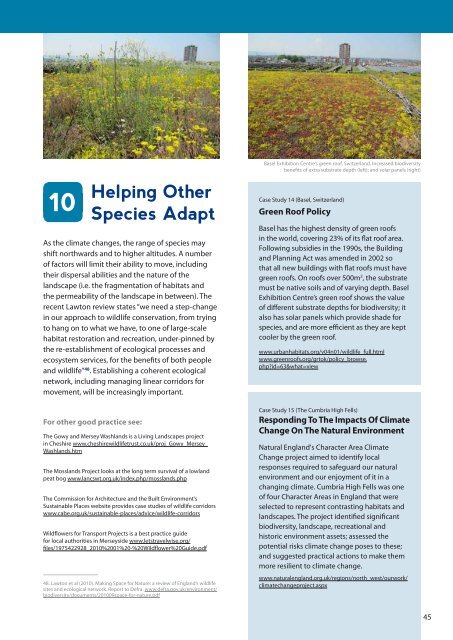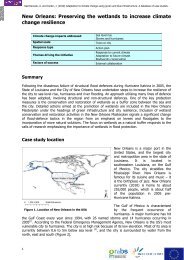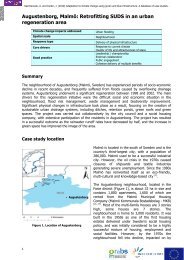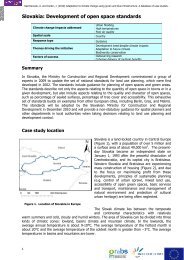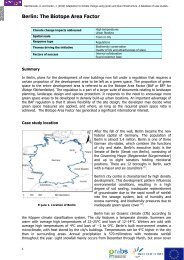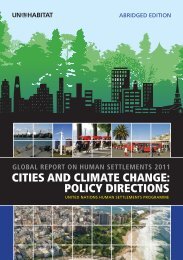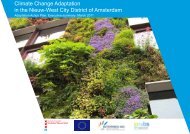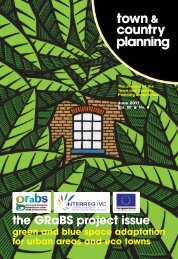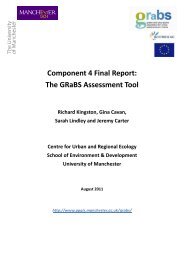Green Infrastructure to Combat Climate Change: A Framework for ...
Green Infrastructure to Combat Climate Change: A Framework for ...
Green Infrastructure to Combat Climate Change: A Framework for ...
Create successful ePaper yourself
Turn your PDF publications into a flip-book with our unique Google optimized e-Paper software.
Basel Exhibition Centre’s green roof, Switzerland. Increased biodiversity<br />
benefits of extra substrate depth (left); and solar panels (right)<br />
10<br />
Helping Other<br />
Species Adapt<br />
As the climate changes, the range of species may<br />
shift northwards and <strong>to</strong> higher altitudes. A number<br />
of fac<strong>to</strong>rs will limit their ability <strong>to</strong> move, including<br />
their dispersal abilities and the nature of the<br />
landscape (i.e. the fragmentation of habitats and<br />
the permeability of the landscape in between). The<br />
recent Law<strong>to</strong>n review states “we need a step-change<br />
in our approach <strong>to</strong> wildlife conservation, from trying<br />
<strong>to</strong> hang on <strong>to</strong> what we have, <strong>to</strong> one of large-scale<br />
habitat res<strong>to</strong>ration and recreation, under-pinned by<br />
the re-establishment of ecological processes and<br />
ecosystem services, <strong>for</strong> the benefits of both people<br />
and wildlife” 48 . Establishing a coherent ecological<br />
network, including managing linear corridors <strong>for</strong><br />
movement, will be increasingly important.<br />
For other good practice see:<br />
The Gowy and Mersey Washlands is a Living Landscapes project<br />
in Cheshire www.cheshirewildlifetrust.co.uk/proj_Gowy_Mersey_<br />
Washlands.htm<br />
The Mosslands Project looks at the long term survival of a lowland<br />
peat bog www.lancswt.org.uk/index.php/mosslands.php<br />
The Commission <strong>for</strong> Architecture and the Built Environment’s<br />
Sustainable Places website provides case studies of wildlife corridors<br />
www.cabe.org.uk/sustainable-places/advice/wildlife-corridors<br />
Wildflowers <strong>for</strong> Transport Projects is a best practice guide<br />
<strong>for</strong> local authorities in Merseyside www.letstravelwise.org/<br />
files/1975422928_2010%2001%20-%20Wildflower%20Guide.pdf<br />
48. Law<strong>to</strong>n et al (2010). Making Space <strong>for</strong> Nature: a review of England’s wildlife<br />
sites and ecological network. Report <strong>to</strong> Defra. www.defra.gov.uk/environment/<br />
biodiversity/documents/201009space-<strong>for</strong>-nature.pdf<br />
Case Study 14 (Basel, Switzerland)<br />
<strong>Green</strong> Roof Policy<br />
Basel has the highest density of green roofs<br />
in the world, covering 23% of its flat roof area.<br />
Following subsidies in the 1990s, the Building<br />
and Planning Act was amended in 2002 so<br />
that all new buildings with flat roofs must have<br />
green roofs. On roofs over 500m 2 , the substrate<br />
must be native soils and of varying depth. Basel<br />
Exhibition Centre’s green roof shows the value<br />
of different substrate depths <strong>for</strong> biodiversity; it<br />
also has solar panels which provide shade <strong>for</strong><br />
species, and are more efficient as they are kept<br />
cooler by the green roof.<br />
www.urbanhabitats.org/v04n01/wildlife_full.html<br />
www.greenroofs.org/gr<strong>to</strong>k/policy_browse.<br />
php?id=63&what=view<br />
Case Study 15 (The Cumbria High Fells)<br />
Responding To The Impacts Of <strong>Climate</strong><br />
<strong>Change</strong> On The Natural Environment<br />
Natural England's Character Area <strong>Climate</strong><br />
<strong>Change</strong> project aimed <strong>to</strong> identify local<br />
responses required <strong>to</strong> safeguard our natural<br />
environment and our enjoyment of it in a<br />
changing climate. Cumbria High Fells was one<br />
of four Character Areas in England that were<br />
selected <strong>to</strong> represent contrasting habitats and<br />
landscapes. The project identified significant<br />
biodiversity, landscape, recreational and<br />
his<strong>to</strong>ric environment assets; assessed the<br />
potential risks climate change poses <strong>to</strong> these;<br />
and suggested practical actions <strong>to</strong> make them<br />
more resilient <strong>to</strong> climate change.<br />
www.naturalengland.org.uk/regions/north_west/ourwork/<br />
climatechangeproject.aspx<br />
45


